
Leptospermum is a genus of shrubs and small trees in the myrtle family Myrtaceae commonly known as tea trees, although this name is sometimes also used for some species of Melaleuca. Most species are endemic to Australia, with the greatest diversity in the south of the continent, but some are native to other parts of the world, including New Zealand and Southeast Asia. Leptospermums all have five conspicuous petals and five groups of stamens which alternate with the petals. There is a single style in the centre of the flower and the fruit is a woody capsule.

Philotheca is a genus of about fifty species of flowering plants in the family Rutaceae. Plants in this genus are shrubs with simple leaves arranged alternately along the stems, flowers that usually have five sepals, five petals and ten stamens that curve inwards over the ovary. All species are endemic to Australia and there are species in every state, but not the Northern Territory.

Nikolai Stepanovich Turczaninow was a Russian botanist and plant collector who first identified several genera, and many species, of plants.
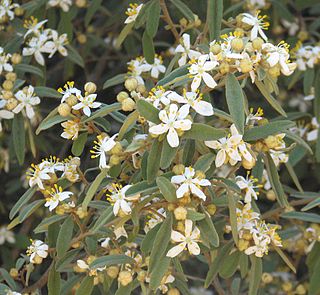
Asterolasia is a genus of seventeen species of erect or prostrate shrubs in the family Rutaceae, and is endemic to Australia. The leaves are simple and arranged alternately, the flowers arranged in umbel-like groups on the ends of branchlets or in leaf axils, usually with five sepals, five petals and ten to twenty-five stamens. There are seventeen species and they are found in all Australian mainland states but not in the Northern Territory.

Phebalium is a genus of thirty species of shrubs or small trees in the family Rutaceae and is endemic to Australia. The leaves are arranged alternately, simple and often warty, the flowers arranged singly or in umbels on the ends of branchlets or in leaf axils, usually with five sepals, five petals and ten stamens. There are about thirty species and they are found in all Australian states but not in the Northern Territory.
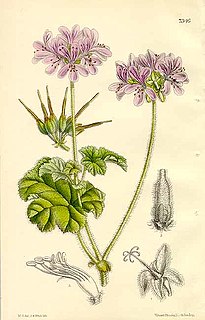
Pelargonium drummondii is a species of Pelargonium found around the southern coasts of Western Australia.

Ceratogyne is a genus of flowering plants in the daisy family.

Argyroglottis is a genus of flowering plants in the daisy family.
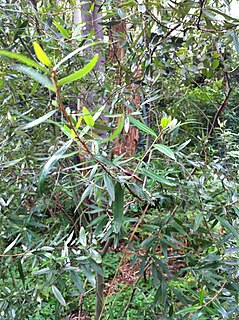
Nematolepis wilsonii is an endangered shrub or small tree species which is endemic to Victoria in Australia. It may grow up to 10 metres tall and has mottled bark. The shiny green leaves are 30 to 80 mm long and 5 to 15 mm wide, and have silvery scales underneath. Star-shaped white flowers are produced in groups of 1 to 9 in the leaf axils in spring.
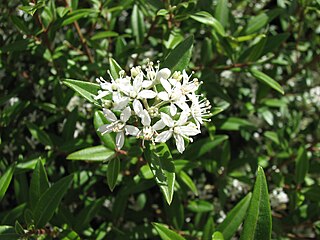
Nematolepis squamea , commonly known as Satinwood, is an upright shrub or small tree species which is endemic to Australia. The species was first formally described in 1805 and named Eriostemon squamea. It was transferred to the genus Phebalium in 1896 and subsequently to Nematolepis by Paul G. Wilson in 1998. The name is derived from the Greek words nematos 'thread', lepsis 'scale' and the Latin word squameus 'scaly' referring to the scales on the leaves, stems and stamens.

Microcybe multiflora is a small shrub species in the family Rutaceae. The species is endemic to Australia. It usually grows to between 0.2 and 1 metre high and produces cream to yellow flowers.
Nematolepis frondosa, commonly known as leafy nematolepis, is a shrub that is endemic to Victoria, Australia. It is a small, conical shaped shrub with glossy leaves, scaly branchlets and white flowers in winter and spring.
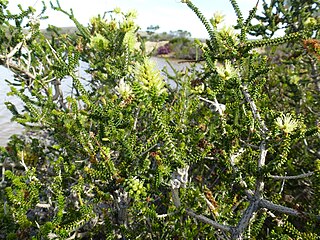
Melaleuca blaeriifolia is an erect to spreading shrub in the myrtle family, Myrtaceae and is endemic to a small area in the south-west of Western Australia. It has small leaves and small greenish-yellow flowerheads.
{{speciesbox |image = Melaleuca sparsiflora .jpg |image_caption = |genus = Melaleuca |species = sparsiflora |authority = Turcz. |synonyms_ref = |synonyms = Myrtoleucodendron sparsiflorum(Turcz.) [[Otto Kuntze|Kuntze] }}
Verticordia multiflora is a flowering plant in the myrtle family, Myrtaceae and is endemic to the south-west of Western Australia. It is a small, openly branched shrub with small leaves and groups of scented, bright yellow flowers on the ends of the branches in spring or early summer.
Phebalium microphyllum is a species of small, rounded shrub that is endemic to Western Australia. It has scaly branchlets, leathery, oblong leaves and yellow flowers arranged in umbels of three to six on the ends of branchlets.

Nematolepis phebalioides, is a small, spreading shrub with ascending branches covered in scales, smooth, glossy leaves and pendulous, red tubular flowers with yellow or green tips, flowering from March to December. It is endemic to Western Australia.
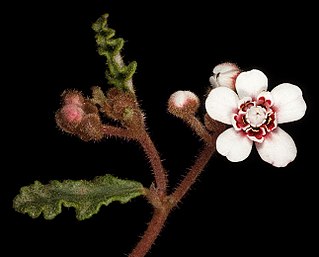
Androcalva pulchella is a shrub in the family Malvaceae. It is native to Western Australia.
Pultenaea calycina is a species of flowering plant in the family Fabaceae and is endemic to near-coastal areas in the south of Western Australia. It is an erect, spindly shrub with flat or more or less cylindrical, grooved leaves and yellow and orange flowers.

Hibbertia mucronata is a species of flowering plant in the family Dilleniaceae and is endemic to the south of Western Australia. It is an erect shrub with hairy branches, crowded, thick, tapering linear leaves ending in a sharp point, and golden yellow flowers with five stamens fused at their bases, all on one side of two densely hairy carpels.















